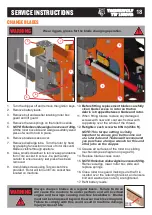
TIMBERWOLF
TW 150DHB
10
The no stress unit controls the feed rate of the material going into the chipping chamber. If the rotor
speed is below the predetermined level, the no stress unit will not allow the feed rollers to work in
either forward or reverse, until the rotor speed rises above the predetermined level. At this point, the
feed rollers will start turning without warning.
Push the
RED STOP
button (see diagram on page 9) or push the
RED SAFETY BAR,
whichever
is the quickest for you to reach. Turn off the engine ignition key.
The emergency stop will prevent
any more material being fed into the chipper. The rotor will still be turning. The engine must be
powered down to stop the rotor.
The engine speed is controlled by the horizontally adjustable lever
shown in the drawing. With the throttle lever in the FAST position the
machine is ready to chip. It MUST be fully pushed to the left to achieve
a suitable working speed. If no wood is to be chipped for a few minutes
the throttle should be returned to the idle position.
MAX
MIN
LOCATE the machine on firm level ground.
CHECK machine is well supported and
cannot move.
CHECK jack stand is lowered and secure.
CHECK all guards are fitted and secure.
CHECK the discharge unit is in place and
fastened securely.
CHECK discharge tube is pointing in a safe direction.
CHECK the feed funnel to ensure no objects
are inside.
CHECK feed tray is in up position - to prevent
people reaching rollers.
CHECK controls as described on page 11.
CHECK (visually) for fluid leaks.
CHECK fuel and hydraulic oil levels.
For parts location see diagrams on pages 3 & 4.
AUTO CONTROLS
EMERGENCY STOPPING
ENGINE CONTROLS
HYDRAULIC OIL LEVEL INDICATOR
DAILY CHECKS BEFORE STARTING
OPERATING INSTRUCTIONS
0
1
2
HOURS
0 0 0 0 0 0 0
BLADE WEAR
The most important part of using a wood chipper is keeping the cutter blades sharp. Timberwolf
chipper blades are hollow ground to an angle of 40 degrees. When performing daily blade checks
ensure blade edge is sharp and free from chips, if there is any evidence of damage, or the edge is “dull”
change the blade(s). The TW 150DHB is fitted with 2 blades 101mm (4") long. They are 44 mm wide
when new. A new blade should chip for up to 25 hours before it requires sharpening. This figure will
be drastically reduced by feeding the machine with stony, sandy or muddy material.
As the blade becomes blunt, performance is reduced. With increased stress and load on the machine
the chips will become more irregular and stringy. At this point the blade should be sent to a reputable
blade sharpening company. The blade can be sharpened several times in its life. A wear mark on the
reverse side indicates the safe limit of blade wear. Replace when this line is exceeded.
The machine is also fitted with a static blade (anvil). It is important that the anvil is in good condition
to allow the cutting blades to function efficiently. Performance will be poor, even with sharp cutter
blades, if the anvil is worn.
The oil level will be visible through the tank wall. It should be within the
upper and lower level marks.
FUEL LEVEL INDICATOR
The fuel level can be seen through the wall of the plastic tank.


























